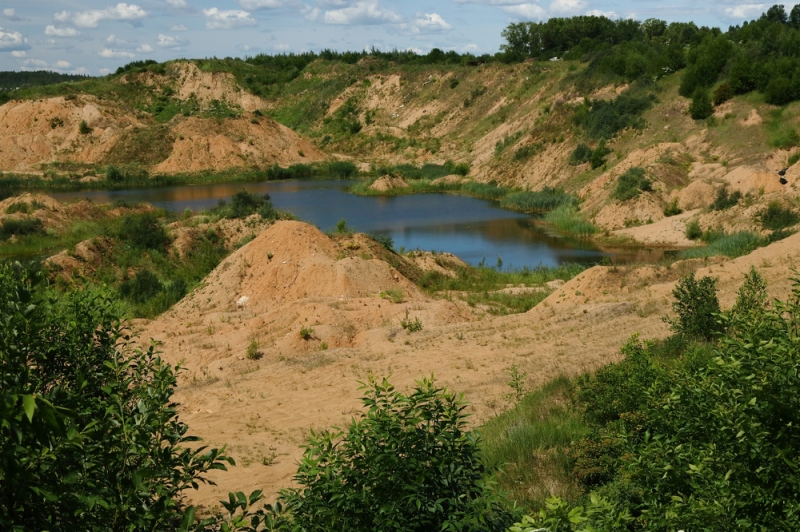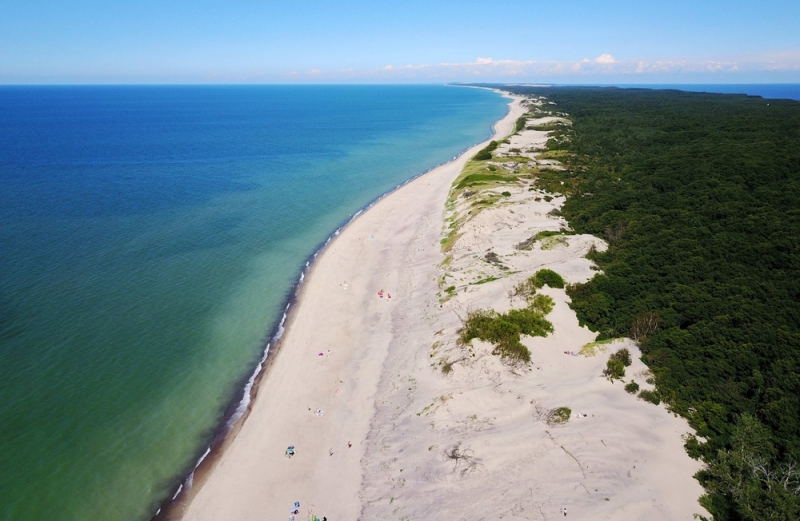
Golden mountains of sand went not only to hot southern countries. If you look hard enough, barchans and dunes will be found in Russia, and sometimes in the most unexpected corners of the country, for example, in Yakutia or the Moscow region. Here are ten places to imagine yourself in the desert.
Film set in Dagestan

Many Russian viewers have seen the Sarykum dune at least once in their lives in the film “White Sun of the Desert.” Its slopes depicted the endless sands of Central Asia. In fact, it is located on the territory of the Dagestan Nature Reserve, about 18 km from Makhachkala. This is one of the largest dunes in Europe: in some places the peaks reach 260 m in height. A huge dune in the foothills, and not in the desert, is an unusual phenomenon. It is not surprising that about its origin created many different beautiful legends. But scientists believe that Sarykum consists of sand, which was brought by the wind during the destruction of neighboring ridges. And here’s what’s interesting: the dune accumulates moisture, and water reserves are maintained even during drought.
How to get there:
The most convenient way is by plane to Makhachkala. Ticket prices from Moscow start from 3,700 rubles*. From the capital of Dagestan you can get to the dune by taxi.
Desert in Yakutia

The Tukulany dunes are located in the Yakut taiga. Scientists do not yet know where such an exotic landscape came from in Siberia, but there is a theory that the mini-desert was formed during the Ice Age. These sand mountains are not like ordinary dunes. Their slopes are located against the movement of the wind, although dunes are usually formed according to direction of air flows. In winter, Tulucans freeze to great depths, and in summer they thaw and release moisture. Plant species that are found only on rocks have taken root here. Even the lakes at the foot of the dunes are anomalous. In some reservoirs only carps live, while in others – exclusively pike.
How to get there:
By plane to Yakutsk, the cost of a ticket from Moscow starts from 11,200 rubles*. The nearest dunes are located opposite the village of Bulgunnyakhtakh, it is best to get there as part of a tourist group.
Moscow Sands in Sychevo

The climate in the Moscow region is not conducive to the appearance of desert landscapes. Nevertheless, you can take a photo against the backdrop of sandy mountains just 100 km from the capital near the village of Sychevo, Volokolamsk region. “Man-made dunes” appeared as a result of the activities of a mining and processing plant. Sand extraction for construction near Moscow continues here today: in some areas of the quarry, tourists can watch dump trucks and bulldozers at work. In the area where mining has already been completed, sand dumps remain. They were loved not only by photographers, but also by fans of sandboarding, motor rally and jeep safari.
How to get there:
The journey from Moscow to the settlement of Sychevo by bus will take only no more than two hours, and the ticket price starts from 390 rubles*. You can rent a car: the price per day is 2000 rubles*.
Blue oases in the Tula region

The sandy Romantsevskie Mountains in the Tula region are also known as Konduki, after the name of the nearest village. These man-made dunes are dumps of rocks left on the site of the Ushakovo coal mines. The flooded pits turned into clear blue lakes. Until recently, only local residents knew about this unique landscape, but thanks to bloggers, the careers have become popular. By 2026, the government of the Tula region plans to transform the quarries into a modern park with landscaped territory and observation platforms. Lovers of camping and diving come here. Some tourists call the landscapes of Konduki alien and arrange creative photo sessions on the slopes of the dunes.
How to get there:
You can rent a car or get from Moscow by public transport: there are regular buses to Bogoroditsk (from 780 rubles*). From there it is about 1 km on foot to the sandy mountains.
Sand disaster in the Kaliningrad region

The Curonian Spit, a long strip of sand in the Kaliningrad region, is famous for its dancing trees. But the local dunes receive less attention, although the fight against them is an important stage in the history of the reserve. Uncontrolled cutting down of trees in the middle of the 18th century turned into a real sand disaster by the beginning of the 19th century. The wandering dunes encroached on local residents’ homes and threatened to fill up shipping channels. Mountains of sand up to 70 m high stretched to the very horizon. To stop the spread of the desert, pine trees were planted on the spit. Today, on the slopes of the high Efa dune, observation platforms are organized, from which a beautiful view of the Baltic Sea opens.
How to get there:
A flight to Kaliningrad from the capital costs about 2,500 rubles*. Then you can get to Zelenogradsk by bus (from 130 rubles*) or a rented car (from 2000 rubles*).
Don exotica in Bolshie Buruny

The area of the Bolshie Buruny tract in the Rostov region is approximately 9 square meters. km. Yellow dunes and dunes look like aliens among green valleys and blue rivers. Scientists do not know exactly where the desert came from in these fertile lands, but it caused a lot of trouble for the local residents. Therefore, trees were planted along its borders to prevent the sands from growing. Travelers note: during the day in Bolshie Buruny there is unbearable heat, and in the evening even a woolen blanket cannot save you from the cold. In windy weather, it is better to wear gloves here: coarse quartz sand can scratch your hands. Every motorist can check this for himself. “Bolshiye Buruny” is a nature reserve, to which an asphalt road leads. True, it’s better not to move to the side, you might get stuck in the sand.
How to get there:
You can get to Voronezh by train, from Moscow prices start from 850 rubles*, then go by car – about 370 km to the reserve.
Ice and fire in Buryatia

The Kuitun dunes, located in the Republic of Buryatia, offer breathtaking views of snow-capped mountain peaks. But finding a scenic spot is not easy. Sandy formations in the Barguzin Valley on the eastern shore of Lake Baikal occupy more than 3 hectares, and not all of the territory resembles a desert. Many areas are overgrown with small bushes. The most famous open sand area is at the horseshoe of the Argada River. This is where photographers take spectacular photographs. By the way, part of the capital of Buryatia, Ulan-Ude, also stands on a sand dune. True, this is not very noticeable due to the thickets.
How to get there:
By plane to Ulan-Ude (from Moscow from 13,100 rubles*), and from there by car 55 km along the Kurumkan – Mogoito highway.
Lonely sands in the Astrakhan region

The Big Brother dune may not be the highest among other famous dunes, but it is certainly one of the most noticeable. Lonely, it rises among the green expanses of the Volga River delta in the Astrakhan region. If you look closely, you can see how its peaks move: sometimes they scatter into several peaks, sometimes they gather into one. The strange appearance of the dune is explained by chaotic livestock breeding. The sheep quickly ate all the grass, and a desert formed in place of the fertile lands. Now lizards and snakes live here. Horses, cows and even camels graze nearby. Travelers note: if you park the car directly on the dune, the wheels will get stuck in the sand in about half an hour. And in windy weather, fine dust clogs the camera lens.
How to get there:
To Astrakhan by plane (from Moscow from 3200 rubles*). It is best to go to the dune on SUVs that can overcome sandy routes.
Singing Dune in Kalmykia

In the middle of the steppes of Kalmykia, near the village of Utta, you can hear the dunes singing. Travelers compare these sounds to organ music. The miracle has a scientific basis: the singing of the sands is the result of the friction of grains of sand that crumble from the slopes in windy weather. Scientists have determined that once upon a time there was an ancient sea in this territory. Today there is no hint of water in the vast golden sands. Even the animals that live here can hardly stand the heat of the day, let alone tourists! It is not surprising that people endowed the singing dunes with mystical properties. For example, according to one legend, Shaitan sleeps here. There are many wild camels in the sands of Kalmykia, but not far from the dune you can rent a couple of tame humpbacks and feel like a nomad.
How to get there:
You can fly to Stavropol, an air ticket from Moscow costs from 6,000 rubles*. Next, it will be more convenient to rent a car (from 2200 rubles* per day)
UNESCO monument in Tuva

The Tsugeer-Els dunes are located in the Republic of Tuva (Tuva) and are part of the Ubsunur Basin State Natural Biosphere Reserve. This site is a natural monument of UNESCO World Heritage Site. The sandy terrain is in constant motion: dunes and dunes move under the influence of winds that blow from west to east. It is not surprising that you can stumble upon quicksand here. Camels, yaks and other animals live in the reserve. But the main treasure that Tsugeer-Els hides is the water bowl Tore-khol, to which thousands of birds flock.
How to get there:
By plane to Kyzyl (from Moscow from 18,000 rubles*), and from there by car about 250 km along the Yenisei highway.
*Prices valid at time of publication.

